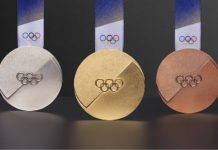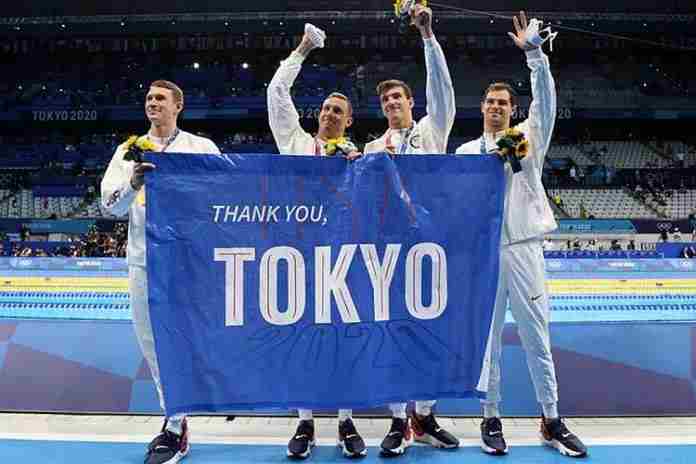(★ Friends: So grateful for our 54 donors, who have covered 96% of our current server & support bill. If you enjoy this coverage, please donate here. Your help is so very much appreciated. Thank you. ★)
Pandemic or not, there was no stopping the United States swim team in Tokyo, as the men and women combined for 30 medals – 11 gold, 10 silver and 9 bronze – across 35 events, earning more than a quarter of the 113 medals won by the U.S., which was the most in the Games.
The U.S. track & field team also scored well, winning 26 medals (7-12-7) across 48 events, but that’s a downgrade from the 32 medals (13-10-9) across 47 events in Rio in 2016. What happened?
One of the secrets to the swimmer’s success was the remarkable performances of the U.S. team compared to their marks at the U.S. Olympic Trials held in Omaha in June. They were ready.
Of the 56 Trials performances – top two in each event – that made the U.S. team, 29 were bettered in Tokyo, using the time for the last round achieved, usually the final. That’s 51.8% of all Olympic Trials performances to make the team being bettered at the Games in a faraway country with strict pandemic regulations.
In four cases, a U.S. swimmer actually bettered their Trials performance in a heat or semifinal, but not in the final. Add those in, and the U.S. team “batting average” in Tokyo was .589 … Hall of Fame stuff indeed.
And it compares favorably with their success in Rio – a Games in a close-to-home time zone, in the Western Hemisphere – when the U.S. had 30 of 52 Trials marks bettered for a batting average of .577, winning 33 medals (16-8-9) across 35 events. And Tokyo was the first time since 2000 that the iconic Michael Phelps was not on the U.S. team.
The U.S. men were good, but the American women were unconscious.
● The men “batted” 11/28 for a .393 average, with three performances in an early round that also bettered their Trials marks. That would edge the totals up to 14/28 or .500.
Of the 14 winning marks at Trials for men, nine were better in Tokyo, a sensational .643 average. This included 2/3 for sprinter Caeleb Dressel, 2/2 for double-gold-medalist Bobby Finke in the distance Freestyles, 2/2 for backstroker Ryan Murphy, who won two medals and 1/1 for 400 m Medley gold medalist Chase Kalisz.
By event group:
Freestyle sprints: 1/4
Freestyle mid-distance: 3/4
Freestyle distance: 2/4
Backstroke: 2/4
Breaststroke: 0/4
Butterfly: 1/4
Medleys: 2/4
Sprinter Michael Andrew, in his first Games, was 0/3, although he did better his Trials mark in the heats of the 100 m Breast, so perhaps 1/3.
● The women were sensational, improving on their Trials marks in 18/28 cases for a .643 average! Add in one more performance in an early round and it’s 19/28 or .679! Wow!
Just looking at the Trials multi-event winners, Katie Ledecky went 3/4, only missing her Trials mark in the 200 m Free (but then swimming a sensational 1:53.76 on the anchor of the 4×200 m relay). The only other two-event winner was Regan Smith, 1/2 in the two Backstroke events. By event group:
Freestyle sprints: 2/4
Freestyle mid-distance: 1/4
Freestyle distance: 4/4
Backstroke: 3/4
Breaststroke: 3/4
Butterfly: 2/4
Medleys: 3/4
This is how the U.S. women won 18 medals in a meet in which Australia’s women won 13, including eight golds. Let’s remember that while Australia and Tokyo are far apart, the time zones are essentially the same. Competing in a “home hemisphere” is a major advantage and the Aussies did well. But the U.S. women gave no quarter.
¶
The U.S. track & field team was much larger with 121 entries into individual events, plus the relay additions. History shows that for track, a “batting average” of over .300 for a Trials vs. Games comparison is quite good.
In Rio in 2016, the U.S. team “batted” .329 – 37.5 of 114 – and won 32 medals. In Tokyo, not as good:
● The U.S. men had better marks at the Games than at the Trials in 17.5 instances out of 56 (no road races are included). That’s a .313 batting average – pretty good – and of the 21 event winners, seven had better marks at the Games (.333).
However, this pales compared to Rio, where the U.S. men had better marks at the Games in 24 out of 57 tries for a mighty .421 average. That’s a big difference.
● The U.S. women did not do as well, with only 12.5 out of 57 Trials performances (no road races) better at the Games: .219 on the batting average.
That’s a bit worse than Rio, when the U.S. women had 13.5 performances out of 57 better at the Games for a .237 average.
By event group for the men:
● Sprints: 3.5/9
● Middle distance: 2/6
● Distance: 6/9
● Hurdles: 1/6 (Rai Benjamin!)
● Vertical jumps: 1.5/6
● Horizontal jumps: 1.5/6
● Throws: 2/11
● Decathlon: 0/3
By event group for the women:
● Sprints: 2.5/9
● Middle distance: 2/6
● Distance: 4/9
● Hurdles: 2/6 (McLaughlin and Muhammad!)
● Vertical jumps: 1/6
● Horizontal jumps: 1/6
● Throws: 0/12
● Heptathlon: 0/3
The women’s numbers were somewhat inflated by the 5,000 m, run in terrible heat in Eugene; Elise Cranny, Karissa Schweizer and Rachel Schneider all ran faster in Tokyo under less oppressive conditions. Remove them and the batting average is down to .194.
So, the final batting average for the U.S. tracksters was .266, that is, just more than a quarter of the U.S. team had better performances in Tokyo than at the Trials. If you take out the women’s 5,000 m altogether, it’s 27/110 or .245.
What does all this tell us?
First, that whatever USA Swimming is doing between the Trials and the Games works, whether in Rio or Tokyo. The performance of its team – more than half of their Trials times were bettered in Tokyo – especially in the face of a souped-up Australian squad that won 20 medals in Tokyo vs. only 10 in Rio, was impressive.
The track & field situation is harder to figure. What’s true is that Rio was in the Western Hemisphere and a lot easier for U.S. athletes to work with. Further, the pandemic caused havoc with the normal training camp and acclimation process for some of the track athletes, although some stars had no difficulties: let’s salute Rai Benjamin, Ryan Crouser, Athing Mu, Sydney McLaughlin, Dalilah Muhammad and the ageless Allyson Felix, all of whom were superb.
USA Track & Field will learn nothing from next year’s selection meet and World Championships in Eugene, but could experiment with the 2023 situation in Budapest, a European venue not so far from Paris, and in the same time zone.
But to have only a quarter of your team perform better at the Games than at the Trials is disappointing, despite the fact that the U.S. won 26 track & field medals in Tokyo, 16 more than second-place Kenya. And has been widely pointed out, the U.S. men did not win a single individual event on the track and only on in the field (Crouser). The women did better, but not by much: two track (Mu and McLaughlin) and two in the field (Katie Nageotte and Valarie Allman).
This is not about more American domination. It’s about maximizing performance. The swimmers did well and can do better. The U.S. track team needs to brings its Trials intensity to the Games. In case anyone cares, Los Angeles 2028 is coming closer every day.
Maybe the two federations could chat?
You can receive our exclusive TSX Report by e-mail by clicking here. You can also refer a friend by clicking here, and can donate here to keep this site going.
For our 649-event International Sports Calendar for 2021 and beyond, by date and by sport, click here!

























